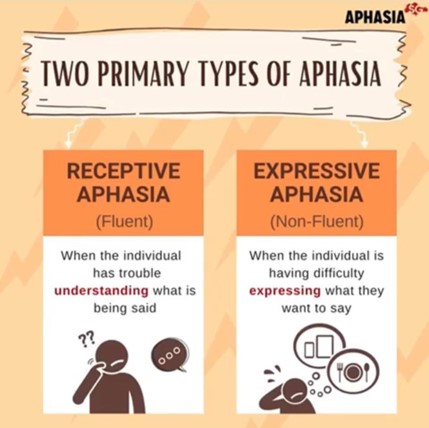A nurse is collecting data from a client who had a stroke and is unable to name common items.
The nurse should recognize that the client is experiencing which of the following types of aphasia?
Receptive aphasia.
Expressive aphasia.
Global aphasia.
Sensory aphasia.
The Correct Answer is B

This type of aphasia is caused by damage to the frontal lobe of the brain, which affects the ability to produce language.
People with expressive aphasia can understand speech and know what they want to say, but they have difficulty saying words or forming sentences.
They may speak in short phrases that require a lot of effort.
Choice A is wrong because receptive aphasia is a type of fluent aphasia that affects the ability to comprehend language.
People with receptive aphasia have difficulty understanding speech and may produce meaningless words or sentences.
Choice C is wrong because global aphasia is the most severe type of aphasia that affects both the production and comprehension of language.
People with global aphasia cannot speak many words and do not understand speech.
They also cannot read or write.
Choice D is wrong because sensory aphasia is not a common term for a type of aphasia.
It may refer to Wernicke’s aphasia, which is another type of fluent aphasia that affects the ability to produce meaningful language.
People with Wernicke’s aphasia can speak fluently but often use incorrect or invented words or phrases.
Nursing Test Bank
Naxlex Comprehensive Predictor Exams
Related Questions
Correct Answer is C
Explanation
- When coordinating the care of a group of clients with assistive personnel (AP), it's important to delegate tasks appropriately based on the AP's scope of practice and training. Here are the tasks that can be assigned to the AP:
Measure the intake and output of a client who has received furosemide: This task involves recording fluid intake and output, which is typically within the scope of practice for an AP, as long as they have been trained in the proper procedure and documentation.
Check a client’s peripheral IV site for redness or swelling: This task involves basic assessment and can be assigned to an AP, as long as they are familiar with the signs of potential complications related to IV sites and have been trained in the facility's protocol for reporting any issues.
Reinforcing teaching with a client about crutch-gait walking: Education and reinforcement of information provided by healthcare professionals can often be delegated to APs, especially if they have received training on the specific topic. However, it's important to ensure that the AP is knowledgeable about crutch-gait walking and the information they are reinforcing.
The task related to assessing pain (e.g., assessing the pain level of a client who has received acetaminophen) should generally be performed by a licensed healthcare provider, such as a nurse. Assessment of pain requires a deeper understanding of the client's pain experience and may involve making clinical decisions related to pain management.
Correct Answer is A
Explanation
The client’s oxygen saturation is 88% on 2 L/min of oxygen via nasal cannula, which is below the normal range of 95% to 100%.
This could indicate that the client is not receiving enough oxygen or that the pulse oximeter is not working properly.
The nurse should first check the sensor probe for any problems, such as poor attachment, nail polish, cold extremities, or motion artifact.
Repositioning the sensor probe may improve the accuracy of the reading and help the nurse determine the next course of action.
Choice B. Apply a cooling blanket to the client is wrong because a cooling blanket is used to lower the body temperature of a client with fever or hyperthermia.
It has no effect on the oxygen saturation level.
Choice C. Place the client in a side-lying position is wrong because a side-lying position may not improve the oxygenation of the client.
A more appropriate position would be a high Fowler’s position, which allows for maximum lung expansion and gas exchange.
Choice D. Ambulate the client is wrong because ambulating the client may worsen the oxygen saturation level if the client has a respiratory condition that causes hypoxemia.
The nurse should assess the client’s respiratory status and oxygen therapy before ambulating the client.
Whether you are a student looking to ace your exams or a practicing nurse seeking to enhance your expertise , our nursing education contents will empower you with the confidence and competence to make a difference in the lives of patients and become a respected leader in the healthcare field.
Visit Naxlex, invest in your future and unlock endless possibilities with our unparalleled nursing education contents today
Report Wrong Answer on the Current Question
Do you disagree with the answer? If yes, what is your expected answer? Explain.
Kindly be descriptive with the issue you are facing.
